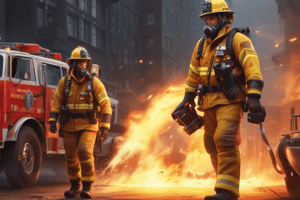Podcast
Questions and Answers
What is one key distinction between management and leadership in fire and emergency services?
What is one key distinction between management and leadership in fire and emergency services?
- Management involves taking risks; leadership avoids them.
- Leadership always involves direct supervision of personnel.
- Management focuses on daily operations; leadership focuses on long-term goals. (correct)
- Leadership is concerned with budgets; management oversees emergency responses.
What is an essential skill for administrators to develop for effective leadership?
What is an essential skill for administrators to develop for effective leadership?
- Political advocacy
- Problem-solving (correct)
- Vehicle maintenance
- Tactical firefighting
Which report emphasized the dual role of fire chiefs as both administrators and emergency incident leaders?
Which report emphasized the dual role of fire chiefs as both administrators and emergency incident leaders?
- Accidental Death and Disability Report
- NFPA Fire Officer Standards
- National Fire Safety Report
- America Burning Report (correct)
What are the three professional qualifications necessary for a fire and EMS administrator?
What are the three professional qualifications necessary for a fire and EMS administrator?
What certification level is recommended for a fire officer seeking to advance in administration?
What certification level is recommended for a fire officer seeking to advance in administration?
Why is it important for fire administrators to have a degree from a regionally accredited institution?
Why is it important for fire administrators to have a degree from a regionally accredited institution?
What is the primary reason staff-line distinctions can cause conflict in FES organizations?
What is the primary reason staff-line distinctions can cause conflict in FES organizations?
What organizational strategy helps address the conflict between staff and line functions in fire departments?
What organizational strategy helps address the conflict between staff and line functions in fire departments?
What is one disadvantage of electing fire administrators rather than appointing them?
What is one disadvantage of electing fire administrators rather than appointing them?
What is a primary advantage of appointing fire administrators in municipal departments?
What is a primary advantage of appointing fire administrators in municipal departments?
Why are standard operating procedures (SOPs) critical in fire and EMS organizations?
Why are standard operating procedures (SOPs) critical in fire and EMS organizations?
What is one challenge administrators face when enforcing SOPs in FES organizations?
What is one challenge administrators face when enforcing SOPs in FES organizations?
What is the role of national consensus standards, such as NFPA standards, in FES organizations?
What is the role of national consensus standards, such as NFPA standards, in FES organizations?
What is a critical factor in gaining support for policy changes in fire and EMS organizations?
What is a critical factor in gaining support for policy changes in fire and EMS organizations?
What method is recommended for gathering feedback from staff in FES organizations?
What method is recommended for gathering feedback from staff in FES organizations?
What is a key benefit of involving a task force in FES decision-making processes?
What is a key benefit of involving a task force in FES decision-making processes?
Why is it important for fire and EMS administrators to engage with the political process?
Why is it important for fire and EMS administrators to engage with the political process?
What is one key strategy for fire administrators when working with elected officials?
What is one key strategy for fire administrators when working with elected officials?
What role do unions play in fire and EMS administration?
What role do unions play in fire and EMS administration?
Why is it important for fire administrators to involve the power elite in the community when proposing major policy changes?
Why is it important for fire administrators to involve the power elite in the community when proposing major policy changes?
What is the main purpose of binding arbitration in FES labor negotiations?
What is the main purpose of binding arbitration in FES labor negotiations?
What is one common issue that FES administrators face when implementing changes?
What is one common issue that FES administrators face when implementing changes?
What is a primary goal of effective administration in FES organizations?
What is a primary goal of effective administration in FES organizations?
What does leadership primarily focus on at the organizational level in FES?
What does leadership primarily focus on at the organizational level in FES?
Why is management essential in FES administration after new resources or changes are implemented?
Why is management essential in FES administration after new resources or changes are implemented?
What type of administrator typically excels at long-term visionary planning but may struggle with day-to-day operations?
What type of administrator typically excels at long-term visionary planning but may struggle with day-to-day operations?
What is a common trait of management-oriented administrators?
What is a common trait of management-oriented administrators?
What issue can arise when a leadership-oriented administrator implements changes too quickly?
What issue can arise when a leadership-oriented administrator implements changes too quickly?
Why is it important for FES administrators to have both leadership and management skills?
Why is it important for FES administrators to have both leadership and management skills?
How do voluntary programs in FES organizations potentially lead to inconsistency?
How do voluntary programs in FES organizations potentially lead to inconsistency?
What could be a positive outcome of introducing mandatory policies following a voluntary program?
What could be a positive outcome of introducing mandatory policies following a voluntary program?
What is a common reason fire and EMS chief officers might oppose organizational changes?
What is a common reason fire and EMS chief officers might oppose organizational changes?
Why is it essential for fire administrators to excel in both leadership and management?
Why is it essential for fire administrators to excel in both leadership and management?
What significant issue does the lack of standardized qualifications in EMS administration create?
What significant issue does the lack of standardized qualifications in EMS administration create?
What is a critical professional qualification for EMS administrators that varies from fire department requirements?
What is a critical professional qualification for EMS administrators that varies from fire department requirements?
What strategy can enhance decision-making in departments with distinct staff-line structures?
What strategy can enhance decision-making in departments with distinct staff-line structures?
What challenge do fire and EMS administrators face due to pressures from various stakeholder groups?
What challenge do fire and EMS administrators face due to pressures from various stakeholder groups?
Why do elected fire administrators find it harder to make robust decisions than appointed ones?
Why do elected fire administrators find it harder to make robust decisions than appointed ones?
What is a primary advantage of implementing standard operating procedures (SOPs) in fire and EMS organizations?
What is a primary advantage of implementing standard operating procedures (SOPs) in fire and EMS organizations?
What factors contribute to the challenge of enforcing SOPs in fire organizations?
What factors contribute to the challenge of enforcing SOPs in fire organizations?
What is a notable benefit of national standards such as NFPA 1021 for fire officer certifications?
What is a notable benefit of national standards such as NFPA 1021 for fire officer certifications?
What is a significant hurdle that administrators face when implementing national standards in their departments?
What is a significant hurdle that administrators face when implementing national standards in their departments?
Why are binding arbitration and principled negotiations crucial in labor disputes within fire and EMS organizations?
Why are binding arbitration and principled negotiations crucial in labor disputes within fire and EMS organizations?
What advantage does receiving peer feedback provide during decision-making?
What advantage does receiving peer feedback provide during decision-making?
How can maintaining good relationships with elected officials benefit fire administrators?
How can maintaining good relationships with elected officials benefit fire administrators?
Flashcards are hidden until you start studying
Study Notes
Management vs. Leadership in Fire and Emergency Services (FES)
- Management focuses on daily operations; leadership focuses on long-term goals.
Essential Skills for FES Administrators
- Problem-solving is a crucial skill for effective leadership.
Landmark Reports on Fire Chief Roles
- The America Burning Report highlighted the dual role of fire chiefs as administrators and emergency incident leaders.
Professional Qualifications for FES Administrators
- Three necessary qualifications are education, training, and experience.
Recommended Certification Level for Advancement
- Fire Officer III or IV is recommended for administrative advancement.
Importance of Regional Accreditation
- Regionally accredited degrees are recognized for their higher education rigor.
Staff-Line Conflicts in FES Organizations
- Conflict arises because line personnel resist moving to staff positions due to reduced emergency response involvement.
Organizational Strategy to Address Staff-Line Conflicts
- Assigning battalion chiefs to supervise both staff and line functions helps address conflict.
Elected vs. Appointed Fire Administrators
- Elected administrators may prioritize reelection over effective leadership.
- Appointed administrators are selected based on qualifications and experience.
Importance of Standard Operating Procedures (SOPs)
- SOPs ensure consistency and prevent freelancing during emergencies.
Challenges in Enforcing SOPs
- Resistance from unionized employees is a major challenge.
Role of National Consensus Standards (e.g., NFPA)
- National standards reduce inconsistencies in operations, staffing, and training.
Gaining Support for Policy Changes
- Clear communication with stakeholders is crucial for gaining support.
Gathering Staff Feedback
- Informal discussions and "management by walking around" are effective feedback methods.
Benefits of Task Forces in Decision-Making
- Task forces represent diverse opinions and organizational levels.
Importance of Political Engagement for FES Administrators
- Elected officials control budgets and influence policy changes.
Strategy for Working with Elected Officials
- Maintaining positive, professional relationships and providing timely information are key.
Role of Unions in FES Administration
- Unions negotiate wages and working conditions for members.
Involving the Power Elite in Policy Changes
- The power elite can significantly influence the success or failure of proposals.
Purpose of Binding Arbitration in Labor Negotiations
- Binding arbitration resolves disputes and creates a binding decision for both parties.
Common Issues in Implementing Changes
- Resistance from staff and stakeholders is a common challenge.
Benefits of Understanding Staff and Line Functions
- A well-rounded understanding improves preparedness for leadership roles.
Importance of National Standards (e.g., NFPA 1021) for Certifications
- National standards ensure consistent qualifications across the country.
Chief Officer's Role in Setting the Agenda for Change
- The chief's authority directs organizational focus and resource allocation.
Studying That Suits You
Use AI to generate personalized quizzes and flashcards to suit your learning preferences.



